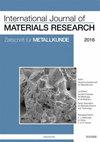Optimization of the extraction of aluminum sulfate and ammonium aluminum sulfate alums from aluminum dross tailings
Abstract
Aluminum dross tailings, an industrial waste from the Egyptian Aluminium Company (Egyptalum), were used to produce two types of alums, namely, aluminum sulfate alum and ammonium aluminum alum via two separate processes. The first process involved leaching the impurities using dilute H_2SO_4 at different solid/liquid ratios and temperatures in the form of soluble sulfates. Some dissolved aluminum was recovered as ammonium aluminum sulfate. The second process involved extraction of aluminum sulfate from the purified dross produced after leaching. This was carried out under atmospheric pressure using different concentrations of H_2SO_4. Influence of temperature, time of reaction, and acid concentration on leaching and extraction processes were studied. X-ray diffraction, atomic absorption spectrometry, and thermal analysis techniques were used.





